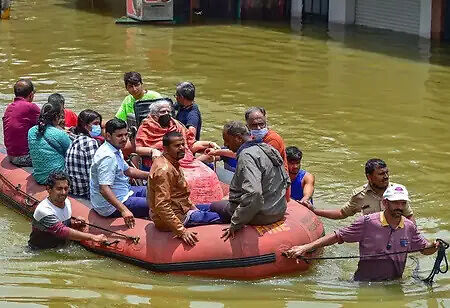
One-Man Army's Resolve Against the Devastating Flood in Bangalore


Bangalore recorded the highest rainfall of about 184.4 mm this August and is said to be the biggest downpour in four years, says the India Meteorological Department (IMD). If traffic and potholes weren’t enough, flooded roads created even more danger, sometimes fatal. These times are when most people step out to play the blame game. On one side, it's the politicians throwing assumptions against their opposing parties; on the flip side, the activists say that it's the poorly maintained infrastructure. Then there are offices, particularly tech companies, which are switching to work-from-home and educational institutions to learning online. Without a proper solution, the economically backward are being swept away by the floods and losing their houses. But the leading cause of the problem seems to be the encroachment of stormwater drains.
To resolve the issue, the Comptroller & Auditor General (CAG) called out to administrative bodies, such as the BBMP (Bruhat Bengaluru Mahanagara Palike), to clear out properties encroached near stormwater drains. This may be a collective effort, but a one-man army is already taking out property encroachment near stormwater drains. For years, Captain (Retired) Santhosh Kumar has observed the condition of lakes and properties residing near them. After much frustration, it was in 2017 that he finally rose to action. This is his story of draining the stormwater from the bottom of the issue.
Gathering Input
Rewinding more than a dozen years, Captain Santhosh moved back to his native, Muthanallur, Anekal taluk, after his retirement in 2008. He couldn’t fathom the bizarre condition of lakes not getting filled despite rain showers. While uncovering the mystery behind this bizarre phenomenon, Captain Santhosh discovered that the water tanker mafia was illegally pumping lakes in Anekal for water supply. Then, from 2017 to 2019, he took it upon himself to investigate the structure of Anekal, collecting data on stormwater drains and lakes in and around the area. The data showed that the main cause of lakes not being filled is encroachment and the non-existence of stormwater drains. With that, he set sail towards his first project in Muthanallur lake.
First Project, 100 Days, Four Rajakaluves, & Rs60 Lakhs
From Muthanallur lake to Bidaraguppe lake, Captain Santhosh spotted four Rajakaluves established in 1923 that were encroached, with one completely lost identity as a drain. This drain became the very first project that he began collecting data on how to clear the encroachment. Starting the work on March 24 last year, Captain Santhosh completely cleared out the drain, stretching about 4km, and connected it with the Batalakere lake, which is just before the Bidaraguppe lake. The task was accomplished with the citizens’ supervision, the Minor Irrigation Department, and the deputy commissioner of Bengaluru Urban district’s permissions. In total, it took about 100 days and a budget of Rs.60 lakh, which was taken care of by donors and the Anekal Taluk Environment Protection Federation.
Learning the Root Cause of the Problem
After successfully filling up the Batalakere lake with rainwater, Captain Santhosh pursued resolving the issue in every lake he came across in the taluk.
Captain Santhosh cleared the Singena Agrahara, and thereon he revived 14 lakes by clearing encroachment on stormwater drains and linking them with other lakes.
From his experience, Captain Santhosh revealed that the lakes he came across are about 1000 years old and have been maintaining themselves until they got encroached by humans.
Some of these lakes were built during the Chola reign by King Rajaraja Chola 1. All through the years, the lakes survived on their own. But the construction activities in the modern era are what led to the encroachment of their survival.
In his analysis, he found that many constructions completely disregarded the buffer zone, which needs to be maintained to the left and right of these drains. Due to this reason, the drains swell and begin flooding.
From his experience, Captain Santhosh said that the only solution to maintaining lakes is to clear the encroachments around them and connect them to the stormwater drains.
His Solution to Prevent Floods
When the drains are encroached, people seldom fail to notice that the water has its own memory. Diverting or building on it will only lead to the drain reclaiming its space during rains. He says that's why old Bangalore is still better off compared to the newer areas that saw rampant encroachments. This falls true since Bangalore rarely had any flood experience until the 2000s.
The city has around 800 km network of stormwater drains, with buildings constructed regardless of where the stormwater drains are located. The captain says that if all encroachments must be torn down, at least 50 percent of the city will have to be demolished.
Thanks to taking action beforehand, Captain Santhosh proudly says that these rains have not flooded the Anekal taluk. Currently, Captain Santhosh is on a mission to connect 11 lakes to stormwater drains in Anekal. The government has given its stamp of approval to the project.
With this, he is keen to show the world that stormwater drains are lifesavers preventing floods.
He further asserts that the stormwater drains throughout Bangalore should be under watch to ensure that flooding never happens. He says that we must protect our Rajakaluves and ensure that good quality drains are built. The floods also proved that merely rejuvenating lakes without maintaining drains is useless.
Meanwhile, citizens have also been demanding that lakes should be treated as flood mitigation centers to allow excess run-off during heavy showers to flow into these water bodies.
Bangalore recorded 1,031 mm of rain since March of this year, and the wettest months of September and October are still to come because of the exit of the southwest monsoon. By mid-November, the period of severe rain starts to subside. According to IMD data, the city had 421 mm of rain between March and May, while 592 mm of rain has been recorded at the observatory since June 1.